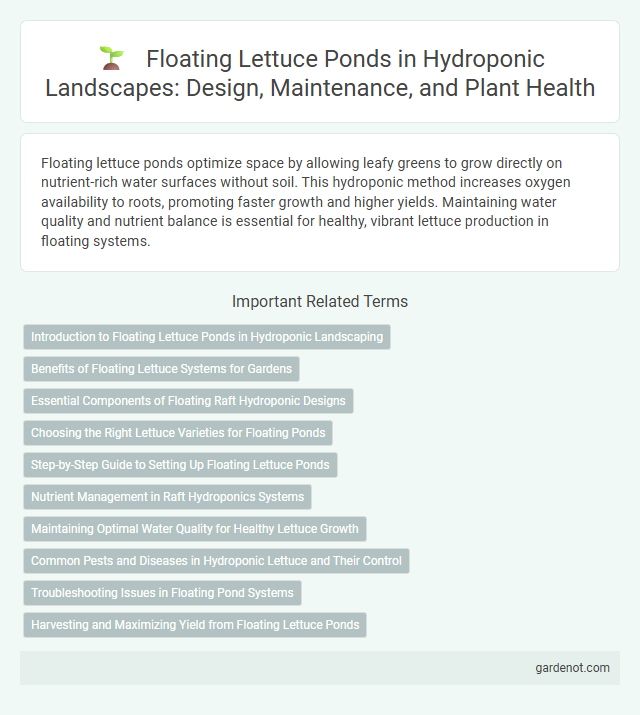Floating lettuce ponds optimize space by allowing leafy greens to grow directly on nutrient-rich water surfaces without soil. This hydroponic method increases oxygen availability to roots, promoting faster growth and higher yields. Maintaining water quality and nutrient balance is essential for healthy, vibrant lettuce production in floating systems.
Introduction to Floating Lettuce Ponds in Hydroponic Landscaping
Floating lettuce ponds utilize buoyant platforms to cultivate lettuce on nutrient-rich water surfaces, promoting efficient space use and water conservation. This hydroponic landscaping method enhances plant growth by optimizing oxygen and nutrient delivery directly to the roots, resulting in faster maturation and higher yields. Floating systems reduce soil dependency, minimize pests, and enable sustainable urban agriculture in limited spaces.
Benefits of Floating Lettuce Systems for Gardens
Floating lettuce systems enhance garden productivity by maximizing space utilization and promoting rapid plant growth through efficient nutrient delivery and oxygenation. These hydroponic setups reduce water usage by up to 90% compared to traditional soil gardening, making them environmentally sustainable and cost-effective. The controlled environment minimizes pest issues and eliminates soil-borne diseases, resulting in healthier, higher-quality lettuce yields.
Essential Components of Floating Raft Hydroponic Designs
Essential components of floating raft hydroponic designs include a buoyant platform, typically made from polystyrene or PVC, that supports the plant-growing trays and ensures stability on the water surface. Nutrient-rich water reservoirs circulate through the raft, providing oxygen and essential minerals directly to the lettuce roots submerged in the solution. An aeration system maintaining dissolved oxygen levels and a reliable water pump to facilitate nutrient flow are critical for optimal growth and preventing root rot in floating lettuce ponds.
Choosing the Right Lettuce Varieties for Floating Ponds
Selecting lettuce varieties suitable for floating ponds involves prioritizing types with robust root systems and rapid growth rates, such as Butterhead, Romaine, and Looseleaf. These varieties thrive in hydroponic environments due to their tolerance for high moisture levels and nutrient-rich water. Opting for disease-resistant and fast-maturing cultivars enhances yield and ensures successful harvest cycles in floating lettuce ponds.
Step-by-Step Guide to Setting Up Floating Lettuce Ponds
Setting up floating lettuce ponds begins with selecting a suitable water container that maintains a stable temperature and supports nutrient circulation. Install buoyant rafts made of foam or polystyrene, ensuring uniform spacing for optimal lettuce growth. Incorporate an aeration system and monitor pH and nutrient levels regularly to promote healthy and sustainable hydroponic lettuce production.
Nutrient Management in Raft Hydroponics Systems
Floating lettuce ponds in raft hydroponics systems require precise nutrient management to optimize plant growth and yield. Maintaining balanced concentrations of essential nutrients such as nitrogen, phosphorus, potassium, calcium, and magnesium in the nutrient solution ensures healthy leaf development and prevents deficiencies or toxicities. Continuous monitoring of pH and electrical conductivity (EC) levels is critical for nutrient uptake efficiency and overall system stability in hydroponic floating raft setups.
Maintaining Optimal Water Quality for Healthy Lettuce Growth
Maintaining optimal water quality in a floating lettuce pond involves monitoring pH levels between 5.5 and 6.5, ensuring dissolved oxygen concentration exceeds 6 mg/L, and regulating nutrient levels, particularly nitrogen, phosphorus, and potassium. Regular water filtration and circulation prevent stagnation and the buildup of harmful pathogens, promoting robust lettuce growth. Precise water temperature control, ideally between 18degC and 22degC, enhances nutrient uptake and reduces plant stress.
Common Pests and Diseases in Hydroponic Lettuce and Their Control
Common pests in hydroponic floating lettuce ponds include aphids, whiteflies, and spider mites, which can cause significant damage to plant leaves and reduce overall yield. Diseases such as powdery mildew, downy mildew, and root rot frequently affect hydroponic lettuce, often triggered by high humidity and poor water circulation. Effective control methods involve maintaining optimal nutrient solution conditions, implementing biological pest control agents like beneficial insects, and using integrated pest management (IPM) strategies to minimize chemical pesticide use.
Troubleshooting Issues in Floating Pond Systems
Floating lettuce pond systems often encounter challenges such as nutrient imbalances, algae overgrowth, and poor oxygenation that can hinder plant growth. Regular monitoring of pH levels between 5.5 and 6.5, maintaining nutrient solution EC around 1.2 to 1.5 mS/cm, and ensuring proper aeration are critical for optimizing lettuce health. Addressing common issues like root rot requires improved water circulation and timely removal of decaying plant matter to prevent system contamination.
Harvesting and Maximizing Yield from Floating Lettuce Ponds
Harvesting floating lettuce from hydroponic ponds requires monitoring optimal leaf size and color to ensure peak freshness and nutrient content. Maximizing yield involves maintaining consistent water temperature, nutrient levels, and pH balance, alongside regular cleaning of floating rafts to prevent algae growth and root entanglement. Employing automated harvesting systems and staggered planting schedules enhances productivity and ensures continuous crop supply.
Floating lettuce pond Infographic

 gardenot.com
gardenot.com